Cameco's Global Commerce: Strategic Direction and Challenges Report
VerifiedAdded on 2020/10/05
|11
|2807
|157
Report
AI Summary
This report provides an analysis of the key factors driving global commerce and trade, focusing on the case of Cameco, a uranium corporation operating internationally. It explores environmental, economic, social, technological, legal, and market factors influencing globalization. The report examines the strategic challenges Cameco faces in the global environment, including political instability, economic fluctuations, social trends, and technological advancements. It then discusses the influences of globalization on organizational governance, leadership, structure, culture, and functions, using the McKinsey 7S framework. Furthermore, the report highlights the impact of ethical and sustainable globalization on organizational functions and evaluates different approaches to decision-making in a global context. Finally, it outlines various routes to internationalization and the associated barriers, offering a comprehensive overview of Cameco's strategic landscape.
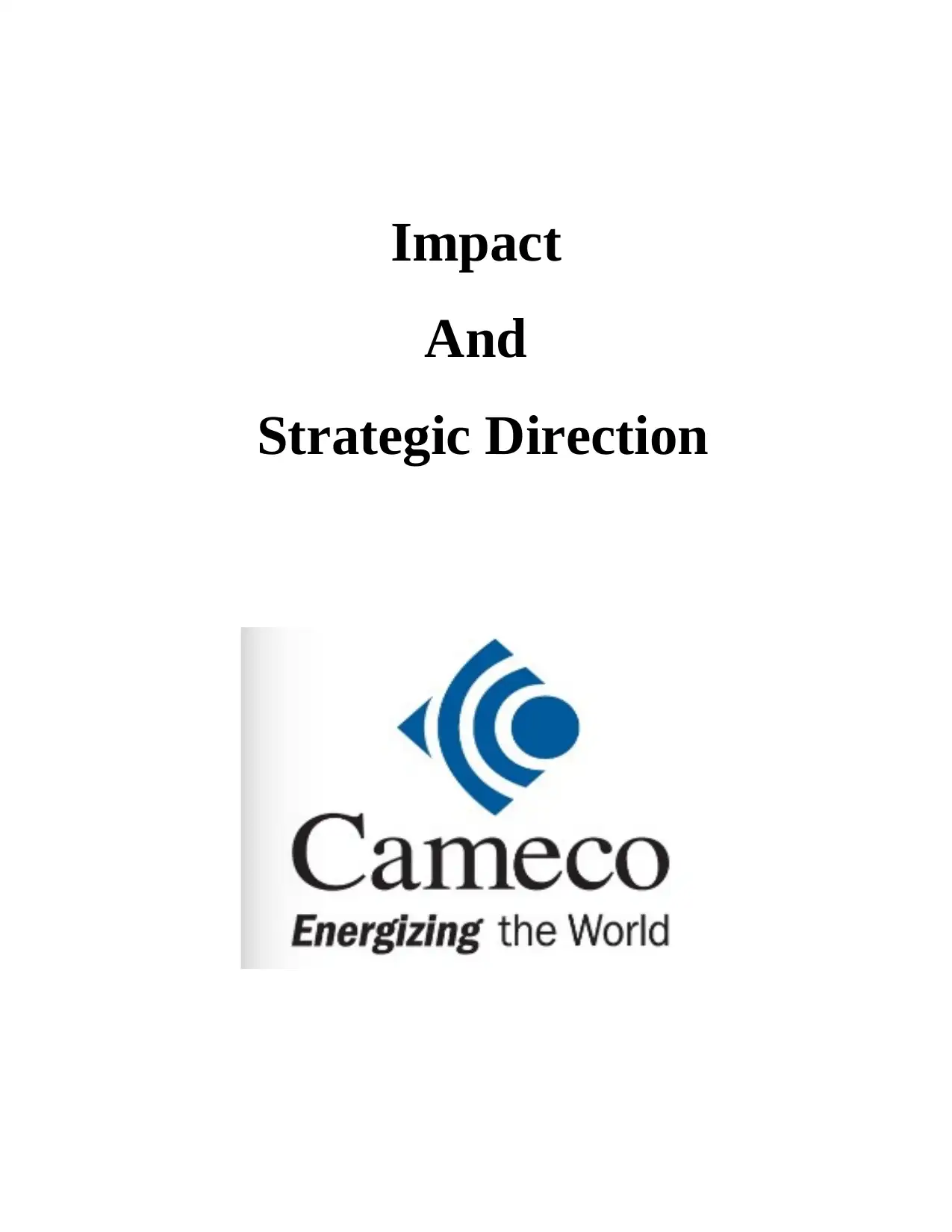
Impact
And
Strategic Direction
And
Strategic Direction
Paraphrase This Document
Need a fresh take? Get an instant paraphrase of this document with our AI Paraphraser
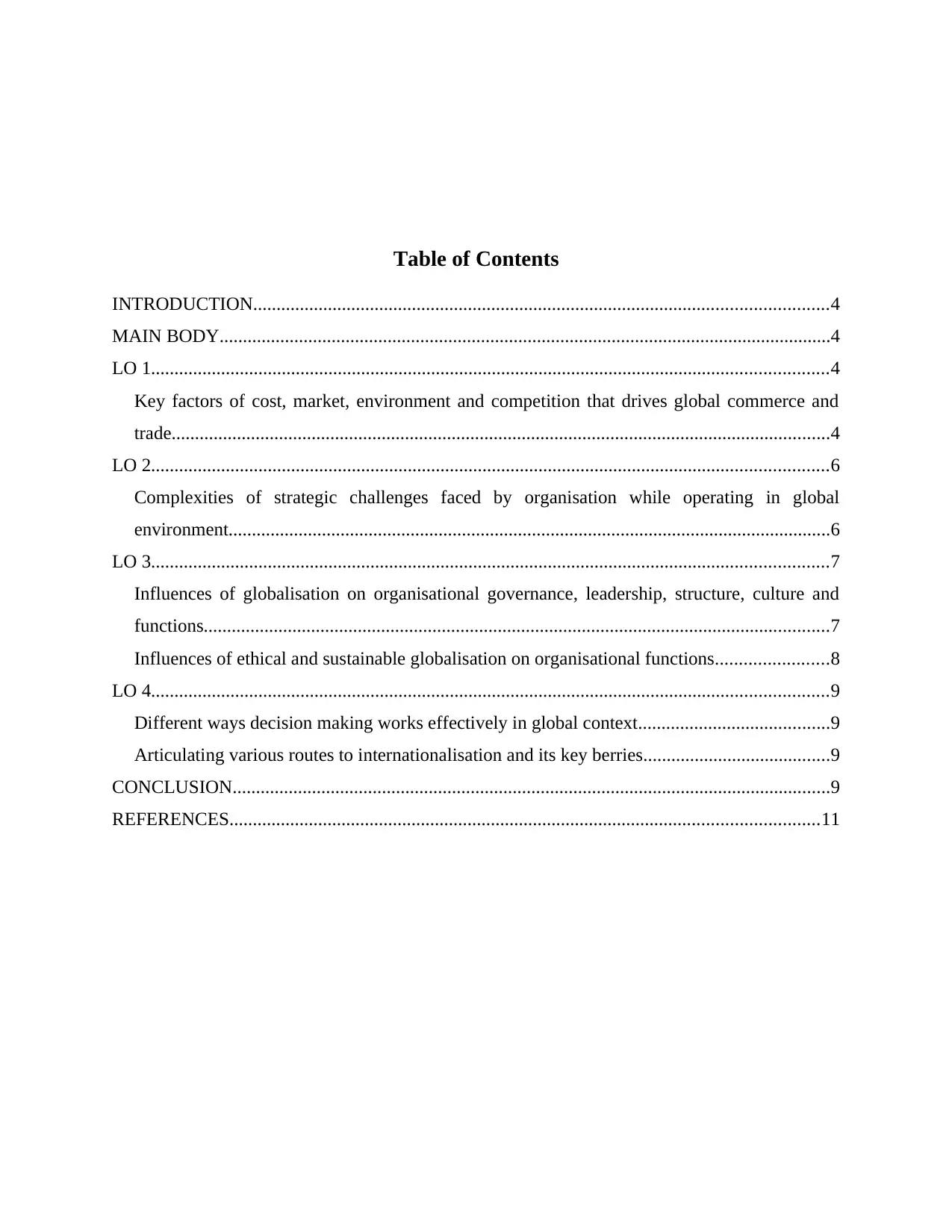
Table of Contents
INTRODUCTION...........................................................................................................................4
MAIN BODY...................................................................................................................................4
LO 1.................................................................................................................................................4
Key factors of cost, market, environment and competition that drives global commerce and
trade.............................................................................................................................................4
LO 2.................................................................................................................................................6
Complexities of strategic challenges faced by organisation while operating in global
environment.................................................................................................................................6
LO 3.................................................................................................................................................7
Influences of globalisation on organisational governance, leadership, structure, culture and
functions......................................................................................................................................7
Influences of ethical and sustainable globalisation on organisational functions........................8
LO 4.................................................................................................................................................9
Different ways decision making works effectively in global context.........................................9
Articulating various routes to internationalisation and its key berries........................................9
CONCLUSION................................................................................................................................9
REFERENCES..............................................................................................................................11
INTRODUCTION...........................................................................................................................4
MAIN BODY...................................................................................................................................4
LO 1.................................................................................................................................................4
Key factors of cost, market, environment and competition that drives global commerce and
trade.............................................................................................................................................4
LO 2.................................................................................................................................................6
Complexities of strategic challenges faced by organisation while operating in global
environment.................................................................................................................................6
LO 3.................................................................................................................................................7
Influences of globalisation on organisational governance, leadership, structure, culture and
functions......................................................................................................................................7
Influences of ethical and sustainable globalisation on organisational functions........................8
LO 4.................................................................................................................................................9
Different ways decision making works effectively in global context.........................................9
Articulating various routes to internationalisation and its key berries........................................9
CONCLUSION................................................................................................................................9
REFERENCES..............................................................................................................................11

⊘ This is a preview!⊘
Do you want full access?
Subscribe today to unlock all pages.

Trusted by 1+ million students worldwide
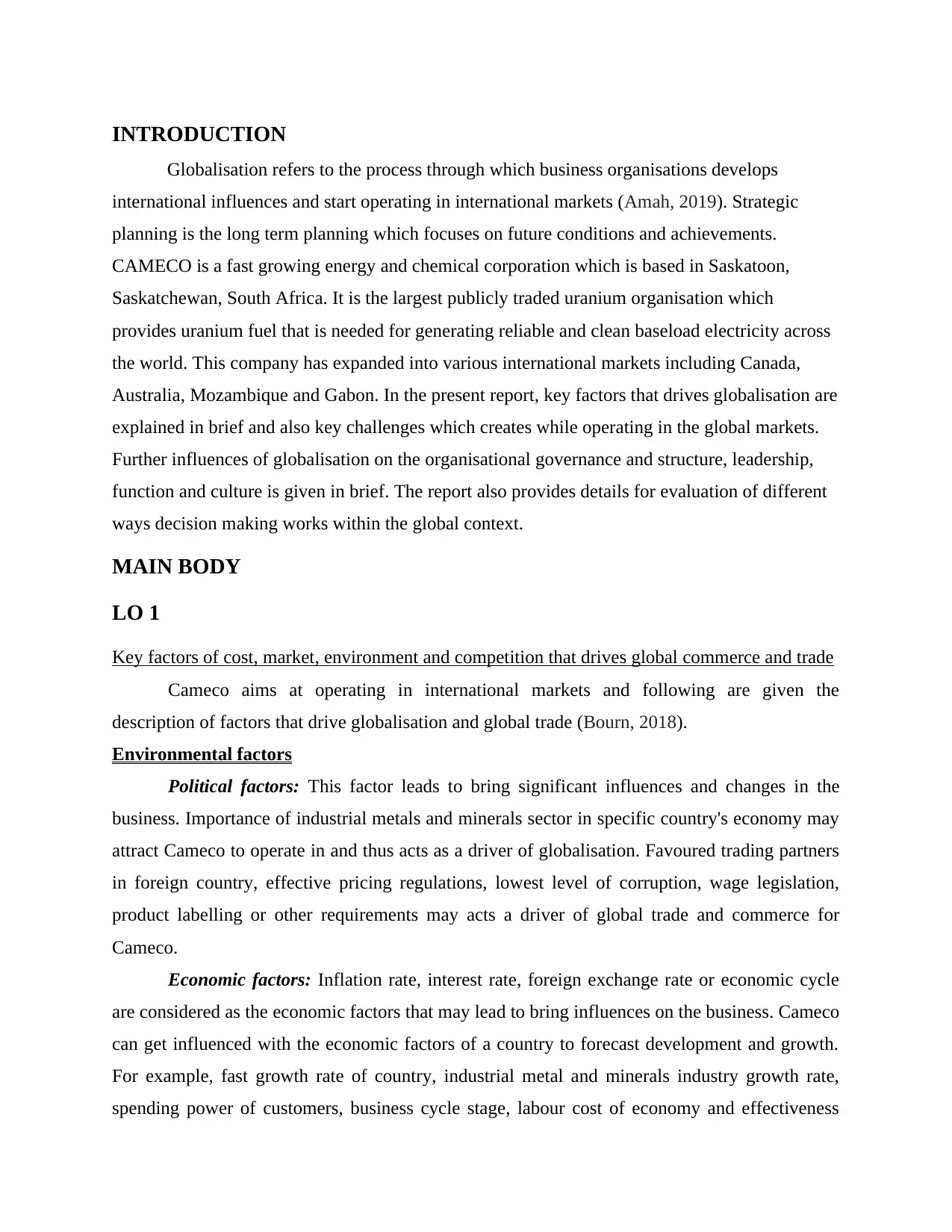
INTRODUCTION
Globalisation refers to the process through which business organisations develops
international influences and start operating in international markets (Amah, 2019). Strategic
planning is the long term planning which focuses on future conditions and achievements.
CAMECO is a fast growing energy and chemical corporation which is based in Saskatoon,
Saskatchewan, South Africa. It is the largest publicly traded uranium organisation which
provides uranium fuel that is needed for generating reliable and clean baseload electricity across
the world. This company has expanded into various international markets including Canada,
Australia, Mozambique and Gabon. In the present report, key factors that drives globalisation are
explained in brief and also key challenges which creates while operating in the global markets.
Further influences of globalisation on the organisational governance and structure, leadership,
function and culture is given in brief. The report also provides details for evaluation of different
ways decision making works within the global context.
MAIN BODY
LO 1
Key factors of cost, market, environment and competition that drives global commerce and trade
Cameco aims at operating in international markets and following are given the
description of factors that drive globalisation and global trade (Bourn, 2018).
Environmental factors
Political factors: This factor leads to bring significant influences and changes in the
business. Importance of industrial metals and minerals sector in specific country's economy may
attract Cameco to operate in and thus acts as a driver of globalisation. Favoured trading partners
in foreign country, effective pricing regulations, lowest level of corruption, wage legislation,
product labelling or other requirements may acts a driver of global trade and commerce for
Cameco.
Economic factors: Inflation rate, interest rate, foreign exchange rate or economic cycle
are considered as the economic factors that may lead to bring influences on the business. Cameco
can get influenced with the economic factors of a country to forecast development and growth.
For example, fast growth rate of country, industrial metal and minerals industry growth rate,
spending power of customers, business cycle stage, labour cost of economy and effectiveness
Globalisation refers to the process through which business organisations develops
international influences and start operating in international markets (Amah, 2019). Strategic
planning is the long term planning which focuses on future conditions and achievements.
CAMECO is a fast growing energy and chemical corporation which is based in Saskatoon,
Saskatchewan, South Africa. It is the largest publicly traded uranium organisation which
provides uranium fuel that is needed for generating reliable and clean baseload electricity across
the world. This company has expanded into various international markets including Canada,
Australia, Mozambique and Gabon. In the present report, key factors that drives globalisation are
explained in brief and also key challenges which creates while operating in the global markets.
Further influences of globalisation on the organisational governance and structure, leadership,
function and culture is given in brief. The report also provides details for evaluation of different
ways decision making works within the global context.
MAIN BODY
LO 1
Key factors of cost, market, environment and competition that drives global commerce and trade
Cameco aims at operating in international markets and following are given the
description of factors that drive globalisation and global trade (Bourn, 2018).
Environmental factors
Political factors: This factor leads to bring significant influences and changes in the
business. Importance of industrial metals and minerals sector in specific country's economy may
attract Cameco to operate in and thus acts as a driver of globalisation. Favoured trading partners
in foreign country, effective pricing regulations, lowest level of corruption, wage legislation,
product labelling or other requirements may acts a driver of global trade and commerce for
Cameco.
Economic factors: Inflation rate, interest rate, foreign exchange rate or economic cycle
are considered as the economic factors that may lead to bring influences on the business. Cameco
can get influenced with the economic factors of a country to forecast development and growth.
For example, fast growth rate of country, industrial metal and minerals industry growth rate,
spending power of customers, business cycle stage, labour cost of economy and effectiveness
Paraphrase This Document
Need a fresh take? Get an instant paraphrase of this document with our AI Paraphraser
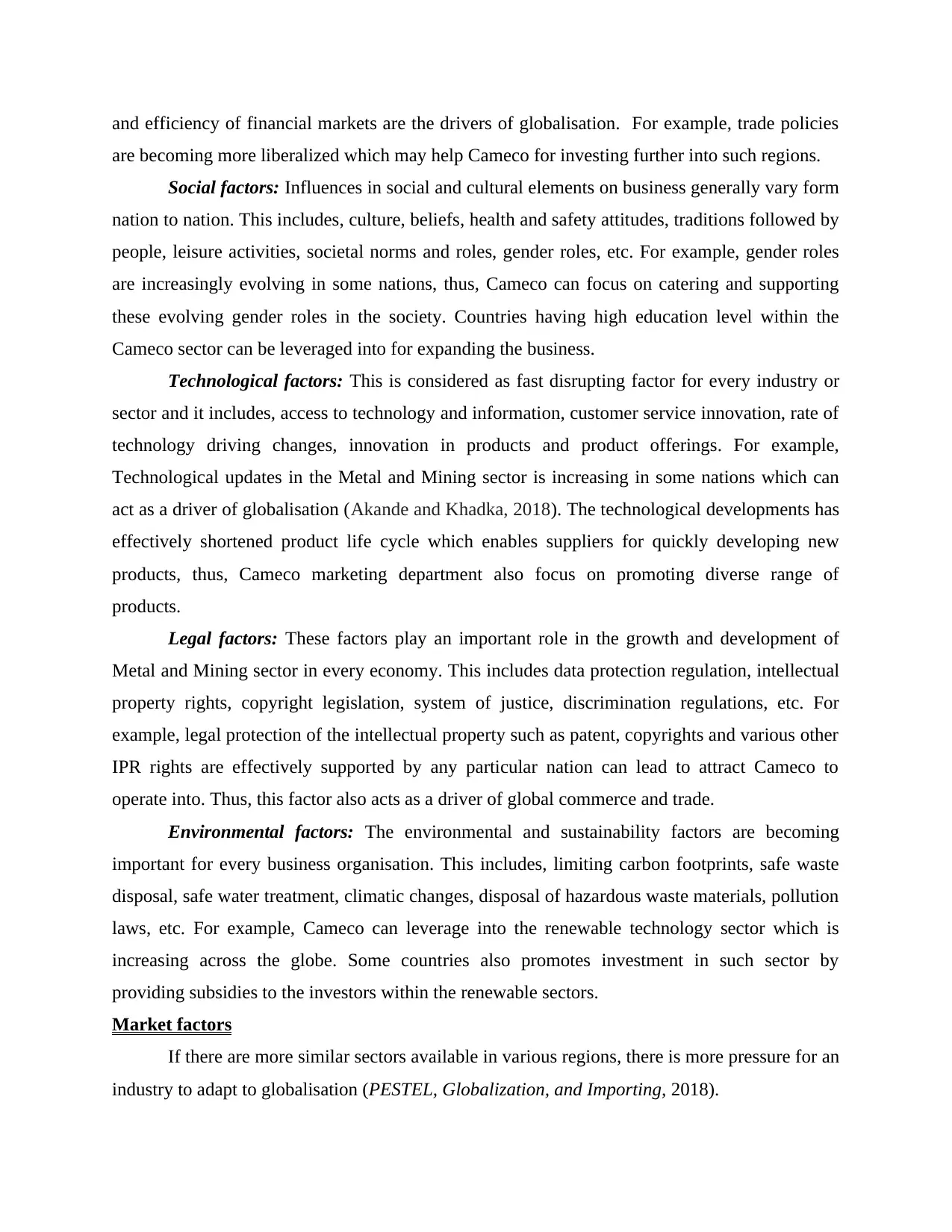
and efficiency of financial markets are the drivers of globalisation. For example, trade policies
are becoming more liberalized which may help Cameco for investing further into such regions.
Social factors: Influences in social and cultural elements on business generally vary form
nation to nation. This includes, culture, beliefs, health and safety attitudes, traditions followed by
people, leisure activities, societal norms and roles, gender roles, etc. For example, gender roles
are increasingly evolving in some nations, thus, Cameco can focus on catering and supporting
these evolving gender roles in the society. Countries having high education level within the
Cameco sector can be leveraged into for expanding the business.
Technological factors: This is considered as fast disrupting factor for every industry or
sector and it includes, access to technology and information, customer service innovation, rate of
technology driving changes, innovation in products and product offerings. For example,
Technological updates in the Metal and Mining sector is increasing in some nations which can
act as a driver of globalisation (Akande and Khadka, 2018). The technological developments has
effectively shortened product life cycle which enables suppliers for quickly developing new
products, thus, Cameco marketing department also focus on promoting diverse range of
products.
Legal factors: These factors play an important role in the growth and development of
Metal and Mining sector in every economy. This includes data protection regulation, intellectual
property rights, copyright legislation, system of justice, discrimination regulations, etc. For
example, legal protection of the intellectual property such as patent, copyrights and various other
IPR rights are effectively supported by any particular nation can lead to attract Cameco to
operate into. Thus, this factor also acts as a driver of global commerce and trade.
Environmental factors: The environmental and sustainability factors are becoming
important for every business organisation. This includes, limiting carbon footprints, safe waste
disposal, safe water treatment, climatic changes, disposal of hazardous waste materials, pollution
laws, etc. For example, Cameco can leverage into the renewable technology sector which is
increasing across the globe. Some countries also promotes investment in such sector by
providing subsidies to the investors within the renewable sectors.
Market factors
If there are more similar sectors available in various regions, there is more pressure for an
industry to adapt to globalisation (PESTEL, Globalization, and Importing, 2018).
are becoming more liberalized which may help Cameco for investing further into such regions.
Social factors: Influences in social and cultural elements on business generally vary form
nation to nation. This includes, culture, beliefs, health and safety attitudes, traditions followed by
people, leisure activities, societal norms and roles, gender roles, etc. For example, gender roles
are increasingly evolving in some nations, thus, Cameco can focus on catering and supporting
these evolving gender roles in the society. Countries having high education level within the
Cameco sector can be leveraged into for expanding the business.
Technological factors: This is considered as fast disrupting factor for every industry or
sector and it includes, access to technology and information, customer service innovation, rate of
technology driving changes, innovation in products and product offerings. For example,
Technological updates in the Metal and Mining sector is increasing in some nations which can
act as a driver of globalisation (Akande and Khadka, 2018). The technological developments has
effectively shortened product life cycle which enables suppliers for quickly developing new
products, thus, Cameco marketing department also focus on promoting diverse range of
products.
Legal factors: These factors play an important role in the growth and development of
Metal and Mining sector in every economy. This includes data protection regulation, intellectual
property rights, copyright legislation, system of justice, discrimination regulations, etc. For
example, legal protection of the intellectual property such as patent, copyrights and various other
IPR rights are effectively supported by any particular nation can lead to attract Cameco to
operate into. Thus, this factor also acts as a driver of global commerce and trade.
Environmental factors: The environmental and sustainability factors are becoming
important for every business organisation. This includes, limiting carbon footprints, safe waste
disposal, safe water treatment, climatic changes, disposal of hazardous waste materials, pollution
laws, etc. For example, Cameco can leverage into the renewable technology sector which is
increasing across the globe. Some countries also promotes investment in such sector by
providing subsidies to the investors within the renewable sectors.
Market factors
If there are more similar sectors available in various regions, there is more pressure for an
industry to adapt to globalisation (PESTEL, Globalization, and Importing, 2018).
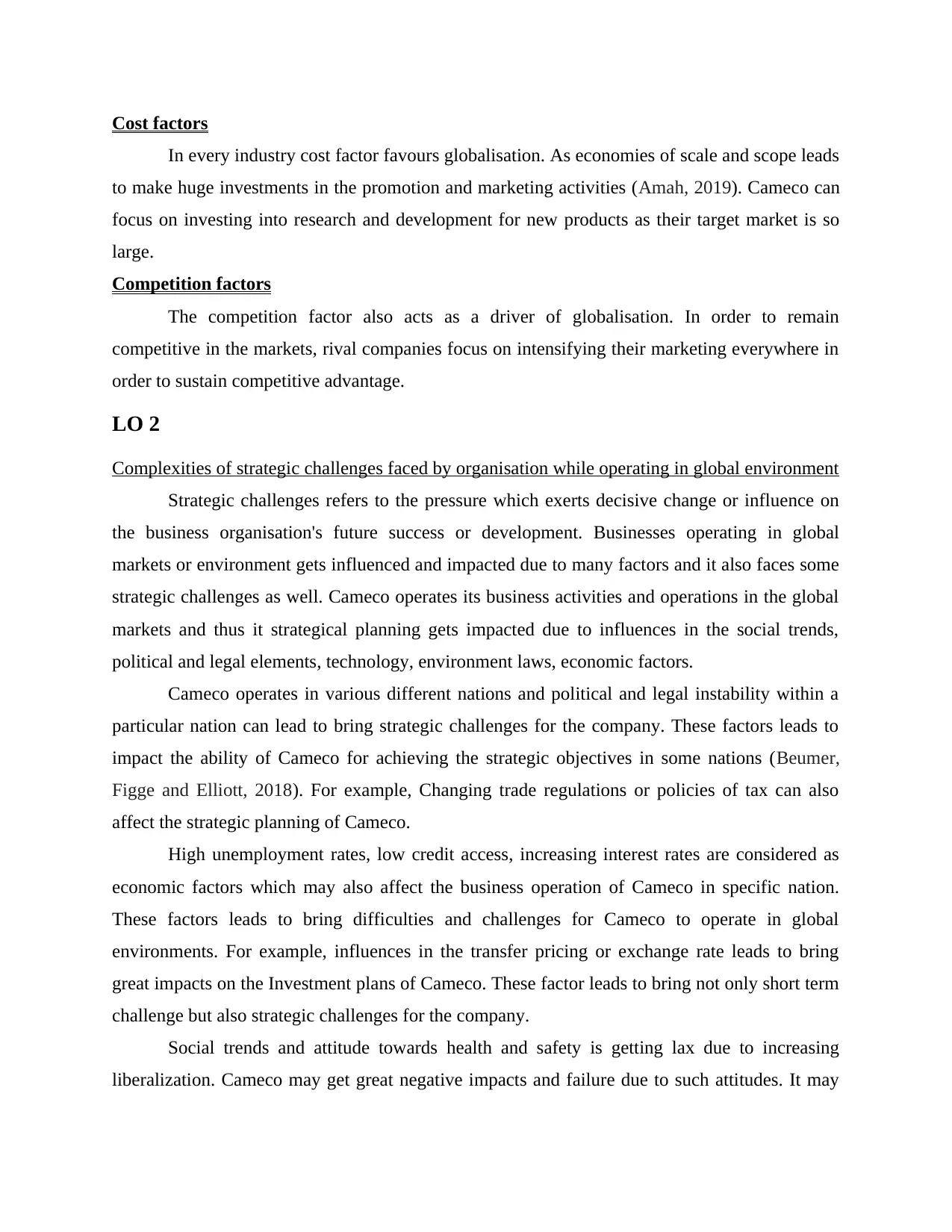
Cost factors
In every industry cost factor favours globalisation. As economies of scale and scope leads
to make huge investments in the promotion and marketing activities (Amah, 2019). Cameco can
focus on investing into research and development for new products as their target market is so
large.
Competition factors
The competition factor also acts as a driver of globalisation. In order to remain
competitive in the markets, rival companies focus on intensifying their marketing everywhere in
order to sustain competitive advantage.
LO 2
Complexities of strategic challenges faced by organisation while operating in global environment
Strategic challenges refers to the pressure which exerts decisive change or influence on
the business organisation's future success or development. Businesses operating in global
markets or environment gets influenced and impacted due to many factors and it also faces some
strategic challenges as well. Cameco operates its business activities and operations in the global
markets and thus it strategical planning gets impacted due to influences in the social trends,
political and legal elements, technology, environment laws, economic factors.
Cameco operates in various different nations and political and legal instability within a
particular nation can lead to bring strategic challenges for the company. These factors leads to
impact the ability of Cameco for achieving the strategic objectives in some nations (Beumer,
Figge and Elliott, 2018). For example, Changing trade regulations or policies of tax can also
affect the strategic planning of Cameco.
High unemployment rates, low credit access, increasing interest rates are considered as
economic factors which may also affect the business operation of Cameco in specific nation.
These factors leads to bring difficulties and challenges for Cameco to operate in global
environments. For example, influences in the transfer pricing or exchange rate leads to bring
great impacts on the Investment plans of Cameco. These factor leads to bring not only short term
challenge but also strategic challenges for the company.
Social trends and attitude towards health and safety is getting lax due to increasing
liberalization. Cameco may get great negative impacts and failure due to such attitudes. It may
In every industry cost factor favours globalisation. As economies of scale and scope leads
to make huge investments in the promotion and marketing activities (Amah, 2019). Cameco can
focus on investing into research and development for new products as their target market is so
large.
Competition factors
The competition factor also acts as a driver of globalisation. In order to remain
competitive in the markets, rival companies focus on intensifying their marketing everywhere in
order to sustain competitive advantage.
LO 2
Complexities of strategic challenges faced by organisation while operating in global environment
Strategic challenges refers to the pressure which exerts decisive change or influence on
the business organisation's future success or development. Businesses operating in global
markets or environment gets influenced and impacted due to many factors and it also faces some
strategic challenges as well. Cameco operates its business activities and operations in the global
markets and thus it strategical planning gets impacted due to influences in the social trends,
political and legal elements, technology, environment laws, economic factors.
Cameco operates in various different nations and political and legal instability within a
particular nation can lead to bring strategic challenges for the company. These factors leads to
impact the ability of Cameco for achieving the strategic objectives in some nations (Beumer,
Figge and Elliott, 2018). For example, Changing trade regulations or policies of tax can also
affect the strategic planning of Cameco.
High unemployment rates, low credit access, increasing interest rates are considered as
economic factors which may also affect the business operation of Cameco in specific nation.
These factors leads to bring difficulties and challenges for Cameco to operate in global
environments. For example, influences in the transfer pricing or exchange rate leads to bring
great impacts on the Investment plans of Cameco. These factor leads to bring not only short term
challenge but also strategic challenges for the company.
Social trends and attitude towards health and safety is getting lax due to increasing
liberalization. Cameco may get great negative impacts and failure due to such attitudes. It may
⊘ This is a preview!⊘
Do you want full access?
Subscribe today to unlock all pages.

Trusted by 1+ million students worldwide
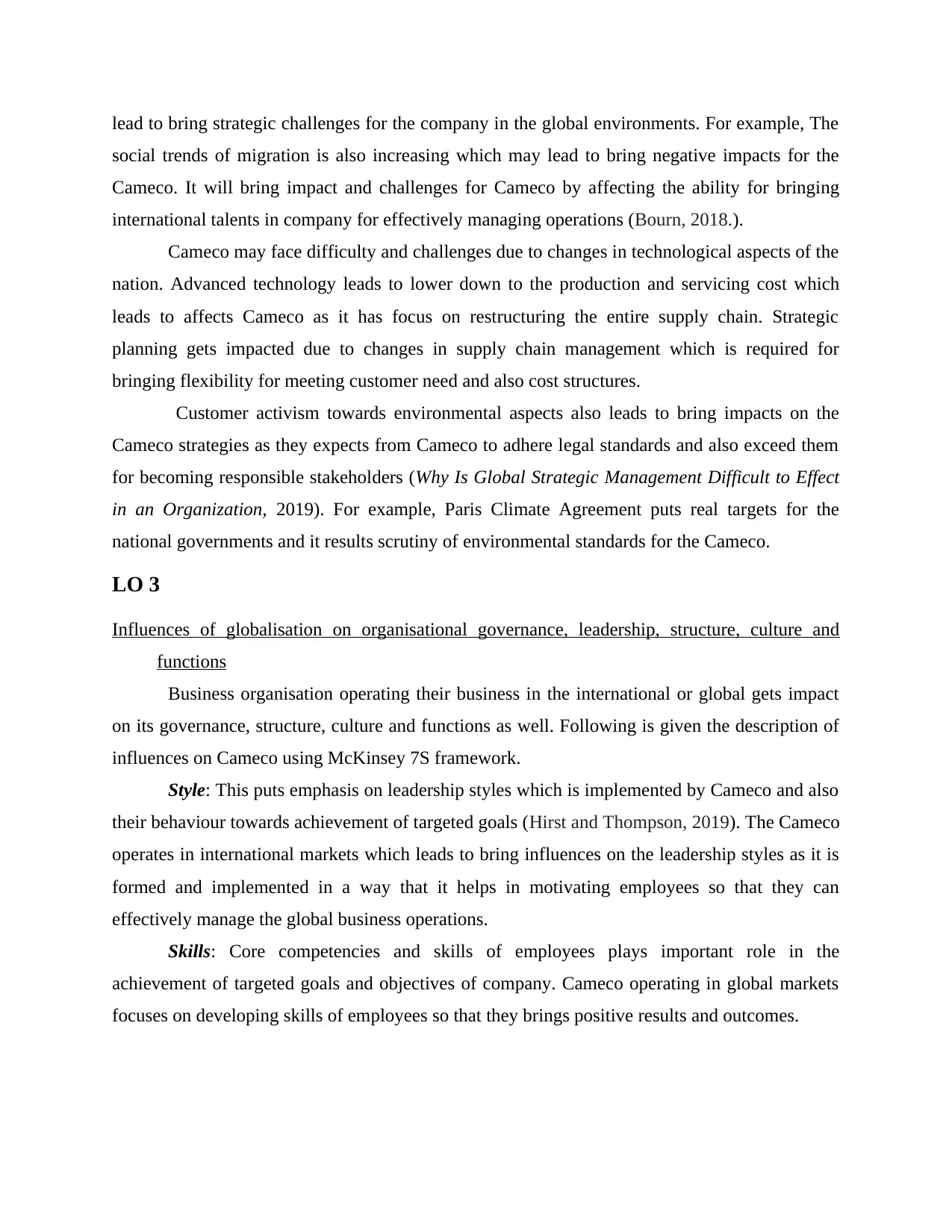
lead to bring strategic challenges for the company in the global environments. For example, The
social trends of migration is also increasing which may lead to bring negative impacts for the
Cameco. It will bring impact and challenges for Cameco by affecting the ability for bringing
international talents in company for effectively managing operations (Bourn, 2018.).
Cameco may face difficulty and challenges due to changes in technological aspects of the
nation. Advanced technology leads to lower down to the production and servicing cost which
leads to affects Cameco as it has focus on restructuring the entire supply chain. Strategic
planning gets impacted due to changes in supply chain management which is required for
bringing flexibility for meeting customer need and also cost structures.
Customer activism towards environmental aspects also leads to bring impacts on the
Cameco strategies as they expects from Cameco to adhere legal standards and also exceed them
for becoming responsible stakeholders (Why Is Global Strategic Management Difficult to Effect
in an Organization, 2019). For example, Paris Climate Agreement puts real targets for the
national governments and it results scrutiny of environmental standards for the Cameco.
LO 3
Influences of globalisation on organisational governance, leadership, structure, culture and
functions
Business organisation operating their business in the international or global gets impact
on its governance, structure, culture and functions as well. Following is given the description of
influences on Cameco using McKinsey 7S framework.
Style: This puts emphasis on leadership styles which is implemented by Cameco and also
their behaviour towards achievement of targeted goals (Hirst and Thompson, 2019). The Cameco
operates in international markets which leads to bring influences on the leadership styles as it is
formed and implemented in a way that it helps in motivating employees so that they can
effectively manage the global business operations.
Skills: Core competencies and skills of employees plays important role in the
achievement of targeted goals and objectives of company. Cameco operating in global markets
focuses on developing skills of employees so that they brings positive results and outcomes.
social trends of migration is also increasing which may lead to bring negative impacts for the
Cameco. It will bring impact and challenges for Cameco by affecting the ability for bringing
international talents in company for effectively managing operations (Bourn, 2018.).
Cameco may face difficulty and challenges due to changes in technological aspects of the
nation. Advanced technology leads to lower down to the production and servicing cost which
leads to affects Cameco as it has focus on restructuring the entire supply chain. Strategic
planning gets impacted due to changes in supply chain management which is required for
bringing flexibility for meeting customer need and also cost structures.
Customer activism towards environmental aspects also leads to bring impacts on the
Cameco strategies as they expects from Cameco to adhere legal standards and also exceed them
for becoming responsible stakeholders (Why Is Global Strategic Management Difficult to Effect
in an Organization, 2019). For example, Paris Climate Agreement puts real targets for the
national governments and it results scrutiny of environmental standards for the Cameco.
LO 3
Influences of globalisation on organisational governance, leadership, structure, culture and
functions
Business organisation operating their business in the international or global gets impact
on its governance, structure, culture and functions as well. Following is given the description of
influences on Cameco using McKinsey 7S framework.
Style: This puts emphasis on leadership styles which is implemented by Cameco and also
their behaviour towards achievement of targeted goals (Hirst and Thompson, 2019). The Cameco
operates in international markets which leads to bring influences on the leadership styles as it is
formed and implemented in a way that it helps in motivating employees so that they can
effectively manage the global business operations.
Skills: Core competencies and skills of employees plays important role in the
achievement of targeted goals and objectives of company. Cameco operating in global markets
focuses on developing skills of employees so that they brings positive results and outcomes.
Paraphrase This Document
Need a fresh take? Get an instant paraphrase of this document with our AI Paraphraser
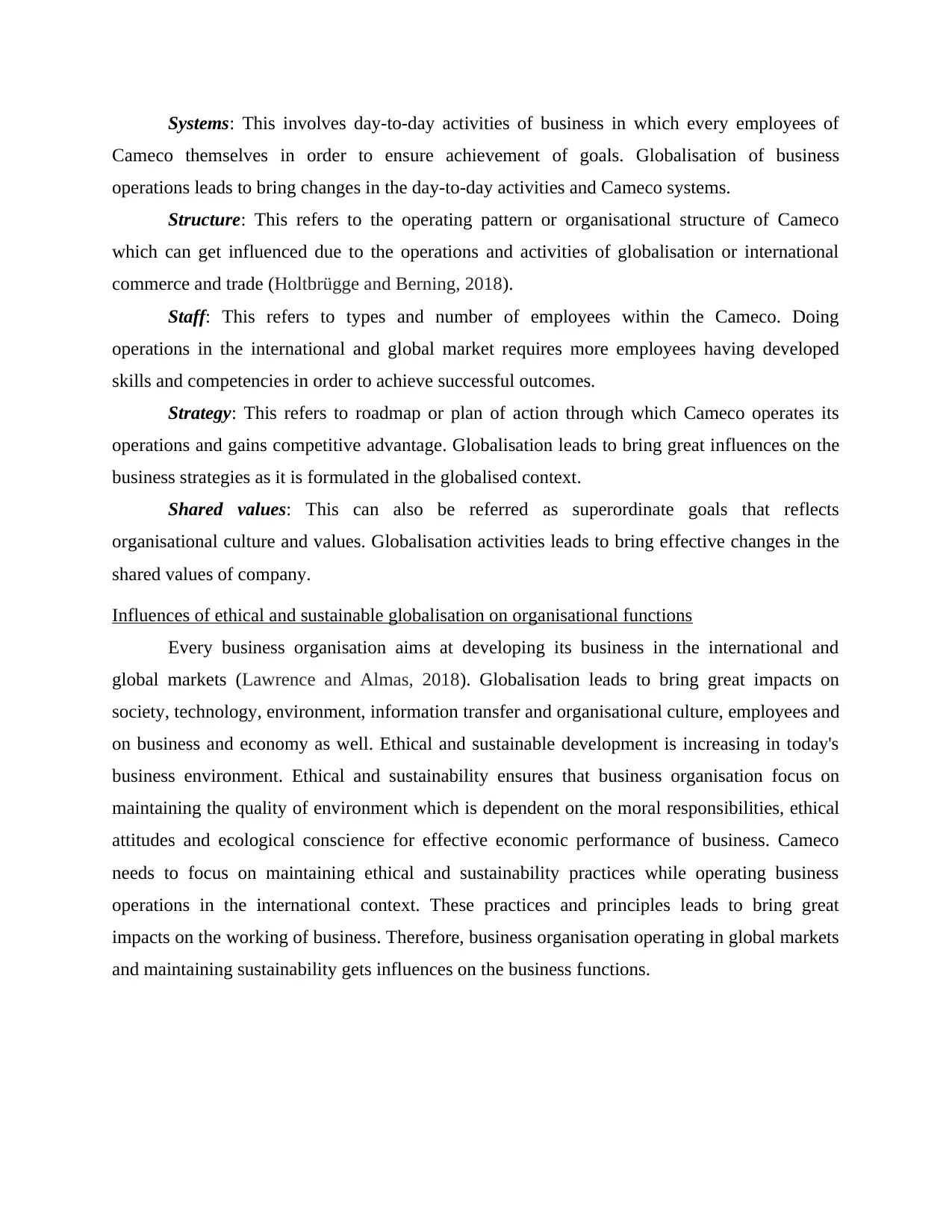
Systems: This involves day-to-day activities of business in which every employees of
Cameco themselves in order to ensure achievement of goals. Globalisation of business
operations leads to bring changes in the day-to-day activities and Cameco systems.
Structure: This refers to the operating pattern or organisational structure of Cameco
which can get influenced due to the operations and activities of globalisation or international
commerce and trade (Holtbrügge and Berning, 2018).
Staff: This refers to types and number of employees within the Cameco. Doing
operations in the international and global market requires more employees having developed
skills and competencies in order to achieve successful outcomes.
Strategy: This refers to roadmap or plan of action through which Cameco operates its
operations and gains competitive advantage. Globalisation leads to bring great influences on the
business strategies as it is formulated in the globalised context.
Shared values: This can also be referred as superordinate goals that reflects
organisational culture and values. Globalisation activities leads to bring effective changes in the
shared values of company.
Influences of ethical and sustainable globalisation on organisational functions
Every business organisation aims at developing its business in the international and
global markets (Lawrence and Almas, 2018). Globalisation leads to bring great impacts on
society, technology, environment, information transfer and organisational culture, employees and
on business and economy as well. Ethical and sustainable development is increasing in today's
business environment. Ethical and sustainability ensures that business organisation focus on
maintaining the quality of environment which is dependent on the moral responsibilities, ethical
attitudes and ecological conscience for effective economic performance of business. Cameco
needs to focus on maintaining ethical and sustainability practices while operating business
operations in the international context. These practices and principles leads to bring great
impacts on the working of business. Therefore, business organisation operating in global markets
and maintaining sustainability gets influences on the business functions.
Cameco themselves in order to ensure achievement of goals. Globalisation of business
operations leads to bring changes in the day-to-day activities and Cameco systems.
Structure: This refers to the operating pattern or organisational structure of Cameco
which can get influenced due to the operations and activities of globalisation or international
commerce and trade (Holtbrügge and Berning, 2018).
Staff: This refers to types and number of employees within the Cameco. Doing
operations in the international and global market requires more employees having developed
skills and competencies in order to achieve successful outcomes.
Strategy: This refers to roadmap or plan of action through which Cameco operates its
operations and gains competitive advantage. Globalisation leads to bring great influences on the
business strategies as it is formulated in the globalised context.
Shared values: This can also be referred as superordinate goals that reflects
organisational culture and values. Globalisation activities leads to bring effective changes in the
shared values of company.
Influences of ethical and sustainable globalisation on organisational functions
Every business organisation aims at developing its business in the international and
global markets (Lawrence and Almas, 2018). Globalisation leads to bring great impacts on
society, technology, environment, information transfer and organisational culture, employees and
on business and economy as well. Ethical and sustainable development is increasing in today's
business environment. Ethical and sustainability ensures that business organisation focus on
maintaining the quality of environment which is dependent on the moral responsibilities, ethical
attitudes and ecological conscience for effective economic performance of business. Cameco
needs to focus on maintaining ethical and sustainability practices while operating business
operations in the international context. These practices and principles leads to bring great
impacts on the working of business. Therefore, business organisation operating in global markets
and maintaining sustainability gets influences on the business functions.
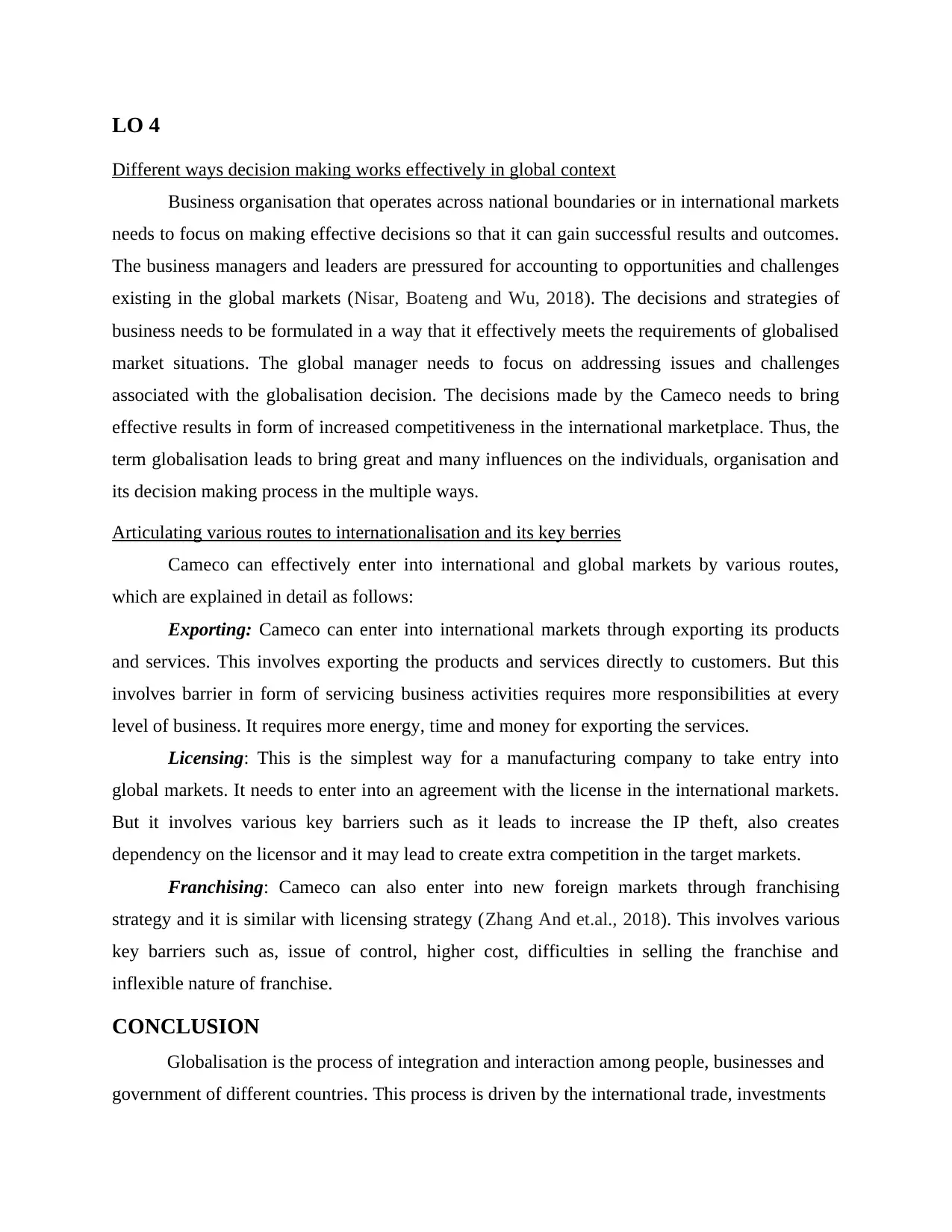
LO 4
Different ways decision making works effectively in global context
Business organisation that operates across national boundaries or in international markets
needs to focus on making effective decisions so that it can gain successful results and outcomes.
The business managers and leaders are pressured for accounting to opportunities and challenges
existing in the global markets (Nisar, Boateng and Wu, 2018). The decisions and strategies of
business needs to be formulated in a way that it effectively meets the requirements of globalised
market situations. The global manager needs to focus on addressing issues and challenges
associated with the globalisation decision. The decisions made by the Cameco needs to bring
effective results in form of increased competitiveness in the international marketplace. Thus, the
term globalisation leads to bring great and many influences on the individuals, organisation and
its decision making process in the multiple ways.
Articulating various routes to internationalisation and its key berries
Cameco can effectively enter into international and global markets by various routes,
which are explained in detail as follows:
Exporting: Cameco can enter into international markets through exporting its products
and services. This involves exporting the products and services directly to customers. But this
involves barrier in form of servicing business activities requires more responsibilities at every
level of business. It requires more energy, time and money for exporting the services.
Licensing: This is the simplest way for a manufacturing company to take entry into
global markets. It needs to enter into an agreement with the license in the international markets.
But it involves various key barriers such as it leads to increase the IP theft, also creates
dependency on the licensor and it may lead to create extra competition in the target markets.
Franchising: Cameco can also enter into new foreign markets through franchising
strategy and it is similar with licensing strategy (Zhang And et.al., 2018). This involves various
key barriers such as, issue of control, higher cost, difficulties in selling the franchise and
inflexible nature of franchise.
CONCLUSION
Globalisation is the process of integration and interaction among people, businesses and
government of different countries. This process is driven by the international trade, investments
Different ways decision making works effectively in global context
Business organisation that operates across national boundaries or in international markets
needs to focus on making effective decisions so that it can gain successful results and outcomes.
The business managers and leaders are pressured for accounting to opportunities and challenges
existing in the global markets (Nisar, Boateng and Wu, 2018). The decisions and strategies of
business needs to be formulated in a way that it effectively meets the requirements of globalised
market situations. The global manager needs to focus on addressing issues and challenges
associated with the globalisation decision. The decisions made by the Cameco needs to bring
effective results in form of increased competitiveness in the international marketplace. Thus, the
term globalisation leads to bring great and many influences on the individuals, organisation and
its decision making process in the multiple ways.
Articulating various routes to internationalisation and its key berries
Cameco can effectively enter into international and global markets by various routes,
which are explained in detail as follows:
Exporting: Cameco can enter into international markets through exporting its products
and services. This involves exporting the products and services directly to customers. But this
involves barrier in form of servicing business activities requires more responsibilities at every
level of business. It requires more energy, time and money for exporting the services.
Licensing: This is the simplest way for a manufacturing company to take entry into
global markets. It needs to enter into an agreement with the license in the international markets.
But it involves various key barriers such as it leads to increase the IP theft, also creates
dependency on the licensor and it may lead to create extra competition in the target markets.
Franchising: Cameco can also enter into new foreign markets through franchising
strategy and it is similar with licensing strategy (Zhang And et.al., 2018). This involves various
key barriers such as, issue of control, higher cost, difficulties in selling the franchise and
inflexible nature of franchise.
CONCLUSION
Globalisation is the process of integration and interaction among people, businesses and
government of different countries. This process is driven by the international trade, investments
⊘ This is a preview!⊘
Do you want full access?
Subscribe today to unlock all pages.

Trusted by 1+ million students worldwide
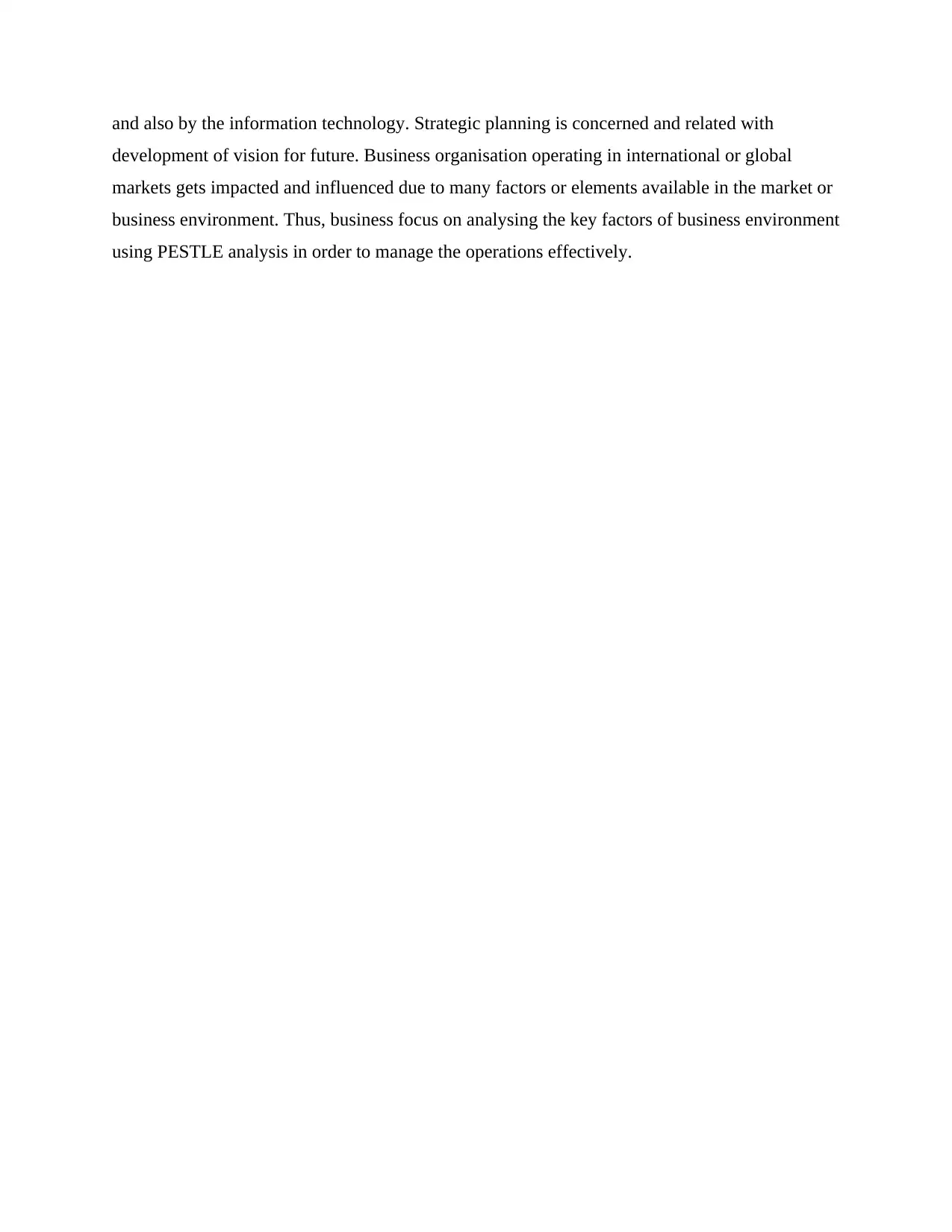
and also by the information technology. Strategic planning is concerned and related with
development of vision for future. Business organisation operating in international or global
markets gets impacted and influenced due to many factors or elements available in the market or
business environment. Thus, business focus on analysing the key factors of business environment
using PESTLE analysis in order to manage the operations effectively.
development of vision for future. Business organisation operating in international or global
markets gets impacted and influenced due to many factors or elements available in the market or
business environment. Thus, business focus on analysing the key factors of business environment
using PESTLE analysis in order to manage the operations effectively.
Paraphrase This Document
Need a fresh take? Get an instant paraphrase of this document with our AI Paraphraser
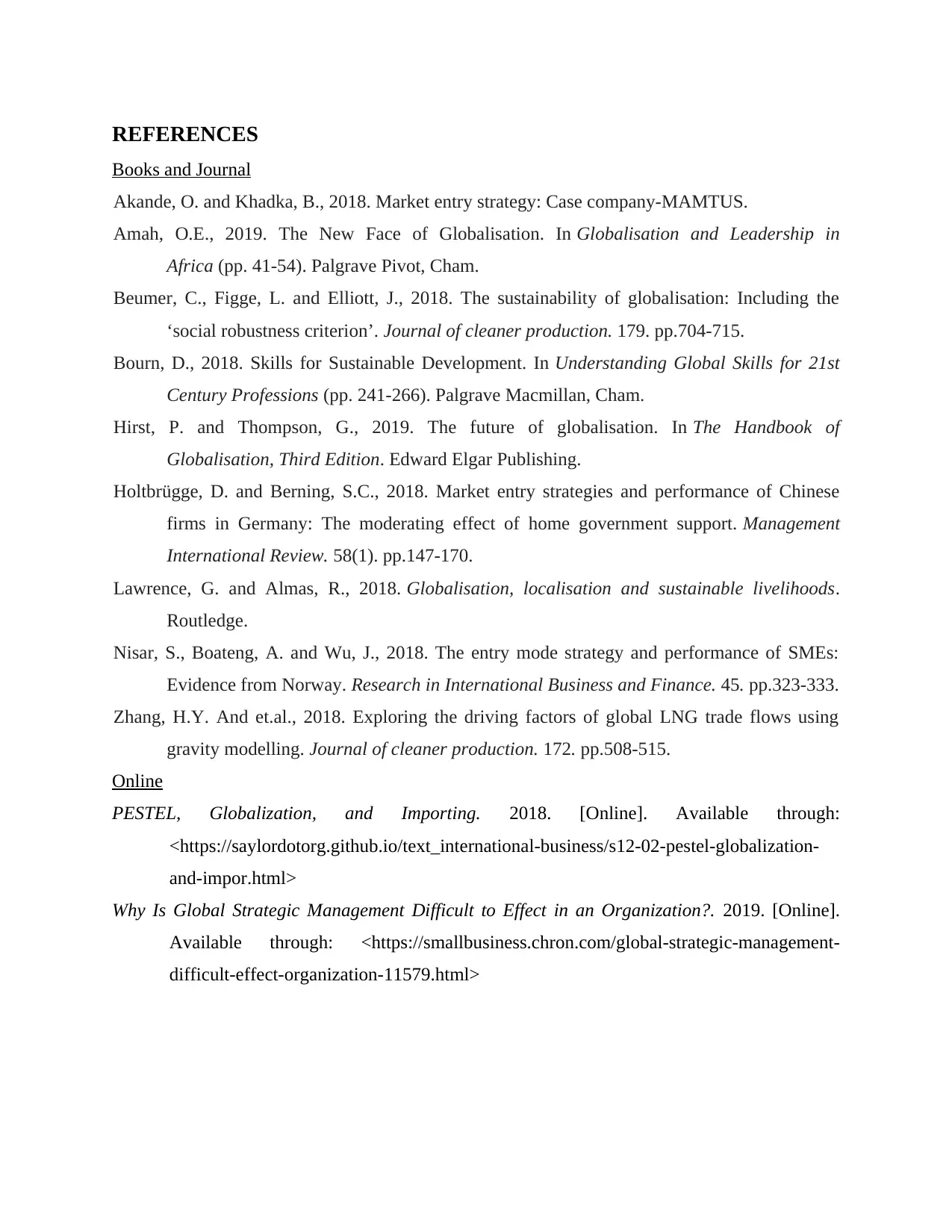
REFERENCES
Books and Journal
Akande, O. and Khadka, B., 2018. Market entry strategy: Case company-MAMTUS.
Amah, O.E., 2019. The New Face of Globalisation. In Globalisation and Leadership in
Africa (pp. 41-54). Palgrave Pivot, Cham.
Beumer, C., Figge, L. and Elliott, J., 2018. The sustainability of globalisation: Including the
‘social robustness criterion’. Journal of cleaner production. 179. pp.704-715.
Bourn, D., 2018. Skills for Sustainable Development. In Understanding Global Skills for 21st
Century Professions (pp. 241-266). Palgrave Macmillan, Cham.
Hirst, P. and Thompson, G., 2019. The future of globalisation. In The Handbook of
Globalisation, Third Edition. Edward Elgar Publishing.
Holtbrügge, D. and Berning, S.C., 2018. Market entry strategies and performance of Chinese
firms in Germany: The moderating effect of home government support. Management
International Review. 58(1). pp.147-170.
Lawrence, G. and Almas, R., 2018. Globalisation, localisation and sustainable livelihoods.
Routledge.
Nisar, S., Boateng, A. and Wu, J., 2018. The entry mode strategy and performance of SMEs:
Evidence from Norway. Research in International Business and Finance. 45. pp.323-333.
Zhang, H.Y. And et.al., 2018. Exploring the driving factors of global LNG trade flows using
gravity modelling. Journal of cleaner production. 172. pp.508-515.
Online
PESTEL, Globalization, and Importing. 2018. [Online]. Available through:
<https://saylordotorg.github.io/text_international-business/s12-02-pestel-globalization-
and-impor.html>
Why Is Global Strategic Management Difficult to Effect in an Organization?. 2019. [Online].
Available through: <https://smallbusiness.chron.com/global-strategic-management-
difficult-effect-organization-11579.html>
Books and Journal
Akande, O. and Khadka, B., 2018. Market entry strategy: Case company-MAMTUS.
Amah, O.E., 2019. The New Face of Globalisation. In Globalisation and Leadership in
Africa (pp. 41-54). Palgrave Pivot, Cham.
Beumer, C., Figge, L. and Elliott, J., 2018. The sustainability of globalisation: Including the
‘social robustness criterion’. Journal of cleaner production. 179. pp.704-715.
Bourn, D., 2018. Skills for Sustainable Development. In Understanding Global Skills for 21st
Century Professions (pp. 241-266). Palgrave Macmillan, Cham.
Hirst, P. and Thompson, G., 2019. The future of globalisation. In The Handbook of
Globalisation, Third Edition. Edward Elgar Publishing.
Holtbrügge, D. and Berning, S.C., 2018. Market entry strategies and performance of Chinese
firms in Germany: The moderating effect of home government support. Management
International Review. 58(1). pp.147-170.
Lawrence, G. and Almas, R., 2018. Globalisation, localisation and sustainable livelihoods.
Routledge.
Nisar, S., Boateng, A. and Wu, J., 2018. The entry mode strategy and performance of SMEs:
Evidence from Norway. Research in International Business and Finance. 45. pp.323-333.
Zhang, H.Y. And et.al., 2018. Exploring the driving factors of global LNG trade flows using
gravity modelling. Journal of cleaner production. 172. pp.508-515.
Online
PESTEL, Globalization, and Importing. 2018. [Online]. Available through:
<https://saylordotorg.github.io/text_international-business/s12-02-pestel-globalization-
and-impor.html>
Why Is Global Strategic Management Difficult to Effect in an Organization?. 2019. [Online].
Available through: <https://smallbusiness.chron.com/global-strategic-management-
difficult-effect-organization-11579.html>
1 out of 11
Related Documents
Your All-in-One AI-Powered Toolkit for Academic Success.
+13062052269
info@desklib.com
Available 24*7 on WhatsApp / Email
![[object Object]](/_next/static/media/star-bottom.7253800d.svg)
Unlock your academic potential
Copyright © 2020–2025 A2Z Services. All Rights Reserved. Developed and managed by ZUCOL.




![Strategic Challenges & Global Commerce: CAMECO Report, [Course Name]](/_next/image/?url=https%3A%2F%2Fdesklib.com%2Fmedia%2Fimages%2Fjc%2Fc486c00570d04b6a821efb0b3a00a464.jpg&w=256&q=75)
